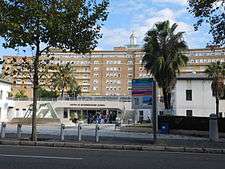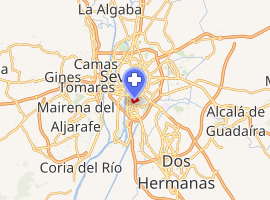Hospital Universitario Virgen del Rocío
Hospital Universitario Virgen del Rocío (Virgen del Rocío University Hospital) is the name of the complex of hospitals located in the center of Sevilla (Andalusia), and one of the most important hospitals [note 1] in the South of Spain, being the biggest hospital in the region. It is managed by the public company "Servicio Andaluz de Salud". HUVR [note 2] is considered one of the best hospitals in Spain.[1]
| Hospital Universitario Virgen del Rocío (HUVR) (Virgen del Rocío University Hospital) | |
|---|---|
 Hospital Virgen del Rocío | |

| |
| Geography | |
| Location | Sevilla, Spain |
| Organisation | |
| Funding | 1955 |
| Affiliated university | University of Seville |
| Patron | Public (SAS) |
| Services | |
| Beds | 1251 |
| Links | |
| Website | www |
| Lists | Hospitals in Spain |
HUVR is one of the regional hospitals of Andalusia, and counts over 8.000 professionals, 54 surgery rooms, 1.291 beds and 450 clinical consultation rooms. It is also affiliated to the University of Seville, being one of the main practical centers for health-care studies.
The complex includes the following hospitals:
- General Hospital
- Traumatology and Rehabilitation Hospital
- Birth and Pediatrics Hospital
- "Duques del Infantado" Hospital
It is famous for being the second Hospital in Spain to perform a successful face transplantation, in 2010.[2]
History
The construction of the hospital began in the 50s, being finally opened in 1955, meaning an important improvement on the state of health care in the province. Its initial name was Residencia Sanitaria García Morato, which was used until the 70s.
The initial design counted only with one main building (nowadays the General Hospital), and was mainly used for surgery proceedings. By the 60s, the management was restructured, dividing the hospital in departments, and a new building was inaugurated in the complex, nowadays the Rehabilitation and Traumatology Hospital, followed by the Birth and Pediatrics Hospital.
Later on, the hospital has incorporated the Regional Center for Blood Transfusions, the female school for nursering (now extinct), the Diagnosticsand Treatment Center and the Pabillion of Pathologic Anatomy. In the 80s, the hospital transferred it management to the regional government (Junta de Andalucia) and signed a collaboration with the University of Seville, obtaining from then on the denomination of "University Hospital".[3]
Area of Influence
The complex is cataloged as a regional hospital, that is, a third level center which offers the medical specialties included in the Spanish Healthcare System.[4]
Its influence area extends through the western side of Andalusia (provinces of Seville and Huelva), which adds around 550.000 inhabitants. The hospital hosts over 8.000 different professionals, with a budget of 516.831.000 euros. In a year, it averages, among others, 50.000 hospitalizations, 300.000 consultations of emergency medicine, 47.000 surgeries, 1.160.000 external consultations, 6.000 births and 280 transplants.[5]
Associated Centers
| Denter | Address |
| Main Campus | Avda. Manuel Siurot, s/n. 41013 Sevilla |
| Hospital General | |
| Hospital de Rehabilitación y Traumatología (Rehabilitation and Trauma) | |
| Hospital de la Mujer (Women's hospital) | |
| Hospital Infantil (Children's hospital) | |
| Centro de Diagnóstico y Tratamiento (Diagnosis and treatment) | |
| Edificio de Laboratorio (Laboratory) | |
| Anatomía Patológica (Pathologic anatomy) | |
| Centro de Documentación Clínica (Clinical documentation) | |
| Edificio de Gobierno (Central management) | |
| Edificio de Gestión de Recursos (Resources management) | |
| Instituto de Biomedicina de Sevilla (Biomedicine) | |
| Cocina (Kitchen) | |
| Lavandería (Laundry) | |
| Hospital Duques del Infantado | C/ Sor Gregoria de Santa Teresa, s/n. 41012 Sevilla |
| C. E. Dr. Fleming | C/ Juan de Padilla, nº 8. 41005 Sevilla |
| C. E. Virgen de los Reyes | C/ Marqués de Paradas, nº 35. 41001 Sevilla |
| Centros de Salud Mental (Mental healthcare): |
Avda. Manuel Siurot, s/n. 41013 Sevilla |
| Unidad de Hospitalización de Salud Mental V. del Rocío (Mental healthcare I) | |
| Hospital de Día Infanto-juvenil V. del Rocío (Children and youth's daytime hospital) | |
| Unidad de Hospitalización Salud Mental H. San Lázaro (Mental healthcare II) | Avda. Dr. Fedriani, nº 56. 41009 Sevilla |
| Hospital de Día Salud Mental (Daytime mental healthcare hospital) | Avda. de Jerez, s/n (Antiguo Hospital Vigil de Quiñones). 41013 Sevilla |
| Unidad de Rehabilitación de Salud Mental V. del Rocío (Rehabilitation and mental healthcare) | Avda. Kansas City, nº 32. 41007 Sevilla |
| Comunidad Terapéutica V. del Rocío I Santa Clara (Therapy I) | C/ Conde de Osborne, nº 3. 41007 Sevilla |
| Comunidad Terapéutica V. del Rocío II Los Bermejales (Therapy II) | Avda. de Jerez, s/n (Antiguo Hospital Vigil de Quiñones). 41013 Sevilla |
| Unidad de Salud Mental Comunitaria Este (Community mental healthcare I) | C/ Juan de Padilla, nº 8, 4ª planta. 41005 Sevilla |
| Unidad de Salud Mental Comunitaria Guadalquivir (Community mental healthcare II) | C/ Marqués de Paradas, nº 49, 1ª planta. 41001 Sevilla |
| Unidad de Salud Mental Comunitaria Mairena (Community mental healthcare III) | C/ Clara Campoamor, nº 10. 41927 Mairena del Aljarafe |
| Unidad de Salud Mental Comunitaria Aljarafe (Community mental healthcare IV) | Avda. Príncipe de España, s/n. 41900 Sanlúcar La Mayor |
| Unidad de Salud Mental Comunitaria Oriente (Sevilla Este) (Community mental healthcare V) | Cueva de la Pileta, s/n 41020 Sevilla |
| Unidad de Salud Mental Comunitaria Sur (Community mental healthcare VI) | Avda. de Manuel Siurot, s/n 41013 Sevilla |
Research and Medical Specialties
The hospital Virgen del Rocio is known for the quality of its research, both inside and outside of Spain. In fact, the Biomedical Research Institute of Seville is managed by the same complex, so that professionals can participate and manage biomedical research projects found in their consultations, easing the transference of research.
Professionals working at the HUVR participate are also part of different excellence efforts, like the European Research Network (ERN),[6] the Reference Centers, Services and Units (CSUR)[7] and the Reference Services in the Andalusian Public Health System (Servicios de Referencia en el Sistema Sanitario Público de Andalucía) [8] working on different projects.
European Research Network (ERN)
- Rare Neuromuscular Diseases European Reference Network
- European Paediatric Oncology Reference Network for Diagnosticos and Treatment (EPO-r-NeT)
- Neuroblastoma
- Rare cancers: Sarcomas and other musculoskeletal tumors both in infants and adults
Reference Centers, Services and Units (CSUR)
- Critical burns
- Infant kidney transplant
- Pelvic osteotomy in adult hip dysplasia
- Resistant osteoarticular infections' treatment
- Infant orthopedics
- Infant allogeneic hematopoietic progenitor transplant
- Reimplantation, including the catastrophic hand
- Cross kidney transplant
- Brachial plexus surgery
- Rare diseases that occur with movement disorders
- Rare Neuromuscular Diseases
- Sarcoma in childhood
- Sarcoma and other musculoskeletal tumors in adults
- Neuroblastoma
- Rare Neuromuscular Diseases
- Renal tumors with vascular involvement (pending resolution)
- Germinal tumors of high and intermediate risk and resistant to first-line chemotherapy in adults (pending resolution)
- Serious Kidney Disease and treatment with dialysis (pending audit)
- Congenital Metabolic Diseases (pending audit)
Reference Services in the Andalusian Public Health System
- Cross kidney transplant
- Kidney transplant from living donor and cadaver
- Liver transplant from cadaver donor
- Adult heart transplant
- Reference laboratory for the molecular study in tuberculosis
- Bladder Exstrophy and Epispadias
- Acute and chronic porphyrias
- Amyotrophic Lateral Sclerosis
- Cystic fibrosis
- Endothelial lamellar keratoplasty (DSAEK)
- Laboratory of metabolopathies. Neonatal screening
- Complex fetal medicine
- Preimplantation Genetic Diagnosis
- Branchial plexus surgery
- Child Orthopedics
- Pelvic osteotome in adult hip dysplasias
- Treatment of resistant osteoarticular infections
- Critical burns
- Reimplantation unit including the catastrophic hand
- Transplantation of allogeneic hematopoietic progenitors infantile
- Neuroblastoma
- Rare diseases that deal with movement disorders
- Kidney transplant in underweight children
Teaching
The HUVR has an agreement with the University of Seville, to improve the knowledge both in experimental and empirical science, and the formation of its professionals (Diagnosis, prognosis, therapy and practical abilities).
The undergraduate activity at the University Hospital adds up to:
- Teachers in the Faculty of Medicine: 81
- Professors of the Faculty of Nursing, Physiotherapy and Podiatry: 31
- Students Degree of Medicine: 558
- Students Degree of Nursing: 230
- Students Degree of Physiotherapy: 174
Regarding postgraduate training, the data are as follows:
- Residential Resident Specialist Tutors: 152
- Accredited places: 178 and offered: 121
- Resident Internal Specialists: 466
Notes
- For the rest of this article it will be used the term 'hospital' to address the set of buildings or complex of hospitals managed under the supervision of the Hospital Universitario Virgen del Rocío, unless specifically stated otherwise
- HUVR is an acronym standing for Hospital Universitario Virgen del Rocío, commonly used in Spain to address this hospital
References
- "El Virgen del Rocío de Sevilla, el octavo mejor hospital público de España". La Vanguardia (in Spanish). Retrieved 12 January 2018.
- "Spanish man appears in public after face transplant".
- "Historia y evolucion del hospital universitario Virgen del Rocio".
- "Administrative and management organization of the Spanish Healthcare System (In Spanish)" (PDF).
- "Memoria 2016 hospitales Virgen del Rocio y Virgen de la Macarena" (PDF).
- "European Reference Networks".
- "Reference Centres Services and Units (In Spanish)".
- "Reference Services in the Andalusian Public Health System (In Spanish)".